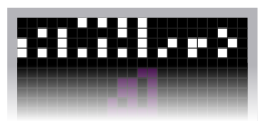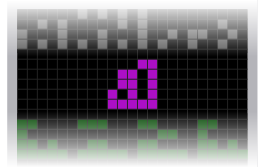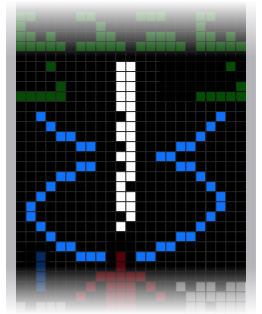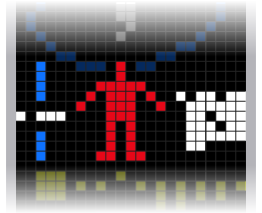Arecibo message

The Arecibo message is a radio message that was beamed into space at a ceremony to mark the remodeling of the Arecibo radio telescope on 16 November 1974. It was aimed at the globular star cluster M13 some 25,000 light years away because it was a large and close collection of stars that was available in the sky at the time and place of the ceremony.[1] The message consisted of 1679 binary digits (equivalent to nearly 205 bytes) transmitted at a frequency of 2380 MHz and modulated by shifting the frequency by 10 Hz, with a power of 1000 kWatt. The beam was extremely narrow (giving a power equivalent to 20 trillion Watts if it were omnidirectional) making it the strongest man-made signal ever sent. The entire transmission lasted 169 seconds and was not repeated.[2] The number 1679 was chosen because it is a semiprime (the product of two prime numbers) and therefore can only be broken down into 23 rows and 73 columns, or 73 rows and 23 columns. This assumes that those who read it will choose to arrange it as a rectangle. The information arranged the first way (23 rows, 73 columns) produces jumbled nonsense, but if arranged the second way (73 rows, 23 columns) it forms the image shown on the right (assuming the bits are arranged from left to right and the rows are arranged from top to bottom; otherwise a flipped image is formed), which is assumed to be recognizable as data.[3]
Reading the image from top to bottom and left to right, it can be divided into 7 parts that state (or show) the following:
- the numbers one (1) through ten (10)
- the atomic numbers of the elements hydrogen, carbon, nitrogen, oxygen, and phosphorus, which make up deoxyribonucleic acid (DNA)
- the formulas for the sugars and bases in the nucleotides of DNA
- the number of nucleotides in DNA, and a graphic of the double helix structure of DNA
- a graphic figure of a man, the dimension (physical height) of an average man, and the human population of Earth
- a graphic of Earth's solar system
- a graphic of the Arecibo radio telescope and the dimension (the physical diameter) of the transmitting antenna dish
Because it will take 25,000 years for the message to reach its intended destination of stars (and an additional 25,000 for any reply), the Arecibo message was more a demonstration of human technological achievement than a real attempt to enter into a conversation with extraterrestrials.
Dr. Frank Drake, then at Cornell University and creator of the famous Drake equation, wrote the message, with help from Carl Sagan, among others. Whether or not this message has any ostensible effects, it has nevertheless forced humanity to consider how it might communicate with extrasolar beings, and what the contents of any such communications might be.
Explanation
Numbers

1 2 3 4 5 6 7 8 9 10 ---------------------- 0 0 0 1 1 1 1 00 00 00 0 1 1 0 0 1 1 00 00 10 1 0 1 0 1 0 1 01 11 01 X X X X X X X X X X <-least-significant-digit marker
The numbers from 1 to 10 appear in binary format (the bottom row marks the beginning of each number).
Even knowing binary, the encoding of the numbers may not be immediately obvious due to the way they have been written. To read the first seven digits, ignore the bottom row, and read them as three binary digits from top to bottom, with the top digit being the most significant.
The readings for 8, 9 and 10 are a little different, as they have been given an additional column next to the first (to the right in the image). This is probably intended to show that numbers too large to fit in a column can be written in several contiguous ones, where the contiguous columns do not have the base marker.
DNA elements

H C N O P 1 6 7 8 15 ---------- 0 0 0 1 1 0 1 1 0 1 0 1 1 0 1 1 0 1 0 1 X X X X X
The numbers 1, 6, 7, 8 and 15 appear. These are the atomic numbers of hydrogen (H), carbon (C), nitrogen (N), oxygen (O) and phosphorus (P), the components of DNA.
The numbers 8 and 15 are written in a logical extension of binary encoding, rather than with the contiguous-columns method shown in the message's number figures at the top:
Nucleotides

Deoxyribose Adenine Thymine Deoxyribose (C5OH7) (C5H4N5) (C5H5N2O2) (C5OH7)
Phosphate Phosphate (PO4) (PO4)
Deoxyribose Cytosine Guanine Deoxyribose (C5OH7) (C4H4N3O) (C5H4N5O) (C5OH7)
Phosphate Phosphate (PO4) (PO4)
The nucleotides are described as sequences of the five atoms that appear on the preceding line. Each sequence represents the molecular formula of the nucleotide as incorporated into DNA (as opposed to the free form of the nucleotide).
For example, deoxyribose (C5OH7 in DNA, C5O4H10 when free), the nucleotide in the top left in the image, is read as:
11000 10000 11010 XXXXX ----- 75010
i.e. 7 atoms of hydrogen, 5 atoms of carbon, 0 atoms of nitrogen, 1 atom of oxygen, and 0 atoms of phosphorus.
Double helix

11 11 11 11 11 01 11 11 01 11 01 11 10 11 11 01 X
1111111111110111 1111101101011110 (binary) = 4,294,441,822 (decimal)
DNA double helix (the vertical bar represents the number of nucleotides, but the value depicted is around 4.3 billion when in fact there are about 3.2 billion base pairs in the human genome).
Humanity

X011011
111111
X0111 110111
111011
111111
110000
1110 (binary) = 14 (decimal)
000011 111111 110111 111011 111111 110110 (binary) = 4,292,853,750 (decimal)
The element in the center represents a human. The element on the left (in the image) indicates the average height of a person: 1764 mm. This corresponds to the horizontally written binary 14 multiplied by the wavelength of the message (126 mm). The element on the right depicts the size of human population in 1974, around 4.2 billion. In this case, the number is oriented horizontally rather than vertically, with the least-significant-digit marker to the upper left in the image.
Planets

Earth Sun Mercury Venus Mars Jupiter Saturn Uranus Neptune Pluto
The solar system, showing the Sun and the planets in the order of their position from the Sun: Mercury, Venus, Earth, Mars, Jupiter, Saturn, Uranus, Neptune, and Pluto. (Pluto is now classified as a dwarf planet, but was still considered a planet at the time the message was written.)
The Earth is the third planet from the Sun - its graphic is shifted up to identify it as the planet from which the signal was sent. The human figure is shown "standing on" the Earth graphic.
In addition to showing position, the graphic provides a general, not-to-scale size reference of each planet and the Sun.
Telescope

bottom two rows:
100101
<--- 111110X --->
100101 111110 (binary) = 2,430 (decimal)
The last part represents the Arecibo radio telescope with its diameter (2430 multiplied by the wavelength gives 306.18 m). In this case, the number is oriented horizontally, with the least-significant-digit marker to the lower right in the image.
Crop circle
A crop circle containing a modified form of the Arecibo message, referred to as the Arecibo reply, was found near Chilbolton's Observatory, Milk Hill, depicting a grey in place of the human figure.[4][5]
See also
References
This article needs additional citations for verification. (September 2006) |
- ^ "Larry Klaes. Ithaca Times - Making Contact". Retrieved 2007-07-27.
- ^ Jay M. Pasachoff. "Chapter 20: Life in the Universe". Astronomy: From the Earth to the Universe, Updates by Chapter, 5th Ed. Retrieved 2007-05-05.
{{cite web}}: External link in|work= - ^ Cassiday, George. "The Arecibo Message]. This also touches upon the confusion regarding arranging the bits from left to right and vice versa". Retrieved 2007-07-27.
- ^ "Paul Vigay. Crop Circle Research: The Chilbolton 'Arecibo message' Formation". Retrieved 2007-07-27.
- ^ Photo of the Arecibo message on a Lucy Pringle's Crop Circle Photography Library.
